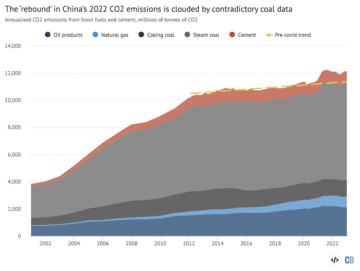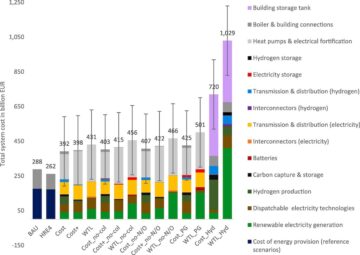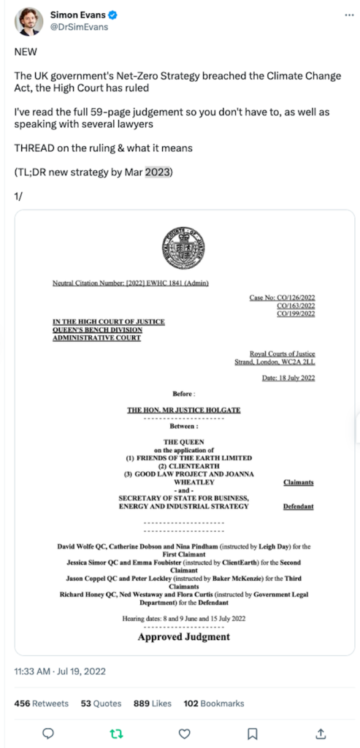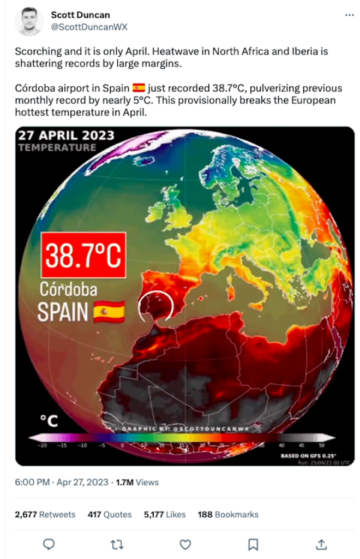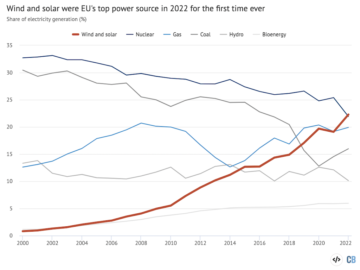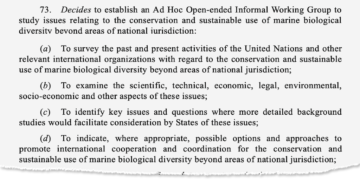Welcome to Carbon Brief’s China Briefing.
Carbon Brief handpicks and explains the most important climate and energy stories from China over the past fortnight.
Snapshot
ELECTRICITY GENERATION: China saw a rapid increase in electricity generation and renewable power capacity in the first five months of 2023.
上微信关注《碳简报》

RECORD-BREAKING HEATWAVE: The capital Beijing recorded its hottest June day in 60 years. The heatwave was linked to climate change in multiple Chinese media outlets.
EV TAX CUT: China extended its 520bn yuan ($72.3bn) tax relief package for the EV industry to 2027, after recording strong growth in production and sales this year.
SPOTLIGHT: In this issue, Carbon Brief looks at a new China-Germany climate agreement and wider climate-related geopolitical tensions.
NEW SCIENCE: Peer-reviewed studies examine China’s climate-smart farm management and energy market reform.
Key Developments
Rising electricity generation and clean capacity
POWER SURGE: China’s electricity output grew again, by 3.9% year-on-year in the first five months of 2023, state central planner the National Development and Reform Commission (NDRC) announced. A key driver was demand from primary industry, which grew by 11.6%, it said. In a post on WeChat, consultancy Guotai Junan Securities Research said that thermal power generation – mainly coal – increased by 6.2%. This was despite wind, solar and nuclear growth of 18.4%, 5.7% and 5.0%, respectively, it noted, with hydropower down 19.2% compared to the same period last year. The post also pointed to record heat as a factor driving electricity demand (see below).
CLEAN CAPACITY: Electricity generating capacity increased by 10% in the first five months of the year to 2,670 gigawatts (GW), China Energy News reported, citing data from China’s National Energy Administration. This included 38% growth in solar capacity, reaching 450GW, while wind reached 380GW, up 13%, the outlet added. Camille Paillard, energy analyst at the International Energy Agency (IEA), told Carbon Brief the solar growth was “impressive”, but raised questions over whether the grid was ready to “accommodate these levels of variable renewable energy”. Power-sector reforms (see China Briefing 15 June) will be key to integrate more renewables, Paillard said.
Subscribe: China Briefing
-
Sign up to Carbon Brief’s free “China Briefing” email newsletter. All you need to know about the latest developments relating to China and climate change. Sent to your inbox every Thursday.
TARGET PRACTICE: China is on track to nearly double wind and solar capacity by 2025, meeting its 2030 target five years early, according to a just-released study from Global Energy Monitor. The research has been covered by BBC News, the Guardian, Bloomberg and Reuters. It highlighted China’s efforts to promote energy storage, demand management and hydrogen production, but said more was needed to integrate variable renewables and push out coal.
EXPERT VIEWS: A Reuters comment by columnist John Kemp said China “leant hard on coal-fired power plants” to “make up for a shortfall in hydroelectric generation as a result of low rainfall across the south since the middle of 2022”. (On Twitter, the Centre for Research on Energy and Clean Air’s Lauri Myllyvirta noted that the hydro shortfall was not only due to low rainfall, with firms saving water for use during the summer peak season.) Earlier this month, online news site Sina China predicted “the main risk” in this summer’s peak period is “still concentrated in hydropower”. State media outlet People’s Daily said the world’s first gigawatt-scale “hydro-solar hybrid” plant – recently completed in Sichuan province with 1GW of solar and 3GW of hydro – would help secure summer electricity supply.
Record-breaking heatwave hits China
‘HOTTEST’ JUNE DAY: Beijing recorded its hottest June day since record-keeping began in 1961 on 23 June, with temperatures reaching 41.1C, BBC News reported. The heat killed at least 17 Beijing citizens, according to Chinese financial outlet Caixin. China’s Central Meteorological Observatory predicted that the high temperature in the Beijing-centred region would last until the end of this week, said the Beijing News. Surface temperatures “exceeded 70C” in some areas, driving demand for cooling, state-supporting newspaper Global Times reported.
WARMING TREND: Xu Xiaofeng, president of the China Meteorological Service Association, told China News Weekly that high temperatures were arriving earlier in the year due to “the overall global warming trend” and the “urban heat island effect”. Wang Weiyue, a meteorological analyst from China Weather Network, also attributed the increasing temperature in Beijing to “global warming” and other factors, the Beijing News reported. Zhou Bing, chief climate officer at the China Meteorological Administration, told the South China Morning Post that El Niño was another reason behind the heatwave and likely to make 2023 the warmest year on record. (Carbon Brief’s previous analysis found 2023 was likely to be one of top four warmest years on record globally.)
AGRICULTURAL JEOPARDY: In the same South China Morning Post article, Zhou said El Niño could bring “floods in the southern regions and droughts in the north”. This could have a “devastating effect” on agriculture, manufacturing and the wider economy, the paper said.
POWER PRESSURE: Online news site Sina Finance, citing a report by National Business Daily, noted that the long heatwave has already raised electricity demand. The China Electricity Council predicts a “possible power shortage” in some regions this summer, said the outlet. However, the Global Times said the country is “well prepared” to meet demand. The Chinese authorities are keeping coal and gas-fired plants “on standby to meet demand and sudden spikes in consumption from the early heat”, Reuters said, citing consultancy Rystad Energy. China’s State Grid said it would “prioritise preventing power outages over its long-term goal of decarbonising the country’s power mix”, Bloomberg reported.
China’s rapid electric vehicle growth
STRONG SALES: Production and domestic sales of “new energy vehicles” (NEVs, mainly electric vehicles) grew by 45% and 47%, respectively, in the first five months of the year, said the NDRC, adding that NEV exports were 1.6 times higher than in the same period in 2022. (Bloomberg said growth had slowed from 120% in the same period last year.) Online magazine the Wire China reported that China’s top EV carmaker BYD has become “the world’s largest producer of EVs” and “the second largest producer of EV batteries”. The Financial Times profiled “the Chinese carmakers planning to shake up the European market”, namely BYD, Nio and Cherry.
POLICY SUPPORT: The NDRC announced ongoing central government support for the EVs. Officials “reiterated their commitment to building more charging infrastructure and promoting EV sales”, with a particular focus on the rural market, Bloomberg reported.
TAX BREAKS: Tax breaks for EVs were extended to 2027, according to the state news agency Xinhua. The incentive has been extended three times since being introduced in 2014, it noted. By the end of 2022, the cumulative tax exemption has exceeded 200bn yuan ($27.7bn) and could surpass 115bn yuan ($15.9bn) next year, Xinhua added. Reuters said the 520bn yuan ($72.3bn) package is the “biggest yet for the industry”.
EUROPE’S WORRY: France is pushing for EU action against what it sees as China’s “unfair advantages in export sectors such as electric vehicles”, Politico reported. Citing “two senior officials” the outlet said the European Commission was discussing an investigation that “could allow Brussels to impose additional levies, known as anti-dumping and anti-subsidy tariffs, on [Chinese] cars”. Business secretary Kemi Badenoch said the UK should avoid being “overly reliant” on Chinese EV batteries, reported the Financial Times.
Spotlight
A new era of geopolitical risks has triggered renewed focus on “derisking” and “decoupling” supply chains – or “reshoring” manufacturing.
Yet China’s dominance in the production of low-carbon technologies means global climate goals will be difficult to meet without cooperation, analysts tell Carbon Brief.
This week’s Spotlight looks at a new China-Germany climate agreement and the wider geopolitical tension between cooperation and competition in the race to net-zero.
WHO: On a recent six-day tour of Europe – his first overseas trip since assuming the role in March – China’s premier Li Qiang signed a deal with German chancellor Olaf Scholz, at a 20 June meeting in Berlin. The deal establishes “a dialogue and cooperation mechanism on climate change and the green transition”, aiming to “promot[e] green and low-carbon transition towards the accelerated implementation of climate action”.
WHAT: The agreement will be implemented by China’s central planner, the National Development and Reform Commission and Germany’s Federal Ministry for Economic Affairs and Climate Action. According to Clean Energy Wire (CLEW), it will include ministerial-level dialogues, an annual plenary and expert exchanges. The outlet says it focuses on closer cooperation at provincial and business level.
The document itself has a strong focus on industrial emissions reduction and points to the cement, steel, chemical, and pulp and paper industries as primary focus areas.
WHEN: The deal was signed just days after Germany published its first-ever national security strategy, which identifies climate change as a key challenge. According to CLEW, this strategy is “tightly intertwined” with two other upcoming German government strategies, on climate foreign policy and on China.
“The perception of China as a current threat to German interests is a common theme in the new German security strategy,” says political scientist and economist Tim Hildebrandt, writing in the Diplomat. However, he says the strategy also recognises China “as an actor without which international problems cannot be solved”.
WHY: The reason for this is simple: China “dominates” supply chains for “most clean energy technologies”, according to the International Energy Agency. Nis Grünberg, lead analyst at thinktank the Mercator Institute for China Studies (MERICS), tells Carbon Brief: “Unfortunately, geopolitical tensions increasingly work their way into climate cooperation.” However, Grünberg adds:
“The necessary speed of decarbonisation globally hinges upon a stable, cheap and growing supply of green tech, which currently only China can provide. A theoretic[al] hard decoupling from Chinese supply would mean a dangerous slow-down of decarbonising energy systems and mobility globally.”
State-affiliated China News says in its coverage that Europe’s energy transition needs China’s technology, while China can benefit from European investments.
WHY ELSE: Another impetus for the talks that led to the deal, according to comments made by Scholz and reported by the Washington Post, is the increasing impact of extreme weather events. Both China and Germany have been experiencing more frequent climate impacts, including extreme weather. The paper quotes Scholz saying: “As major emitters of carbon dioxide, Germany and China bear particular responsibility in the fight against climate change.” Li “proposed tackling climate change as one of the guiding principles for China-Germany cooperation”, Xinhua reported.
WHAT IT MEANS: NGO Germanwatch called the deal a “remarkable step for German climate diplomacy”, noting that as part of the agreement China reiterates its commitment to the 1.5C target and the need for accelerated emissions cuts this decade.
Byford Tsang, senior policy advisor at thinktank E3G, tells Carbon Brief the deal “shows a lot of technical cooperation”, calling for greater alignment on standards-setting, joint pilots and other initiatives. He also notes the potential for increased dialogue to mitigate Chinese concerns over the EU’s carbon border adjustment mechanism (CBAM, see China Briefing 15 June) – or even to strengthen China’s emissions trading system to “create a more meaningful carbon price that better intersects with CBAM”.
Tsang’s colleague Belinda Schäpe, China policy analyst at E3G, tells Carbon Brief “we really have to judge the dialogue based on delivery”. She also highlights areas not covered by the dialogue, including renewable targets and the use of coal.
BIGGER PICTURE: Following his stop in Berlin, Li travelled to Paris to attend the climate finance summit organised by French president Emmanuel Macron. Li used the meeting to call for nations to “rise above differences” to fight climate change and other global problems, Reuters reported. On the sidelines of the summit, Li and French finance minister Bruno Le Maire “said there’s room to deepen commercial ties, with a focus on combating climate change and reforming global finance”, Bloomberg reported. Li also met European Council president Charles Michel, where he “said China stands ready to work with the EU to make a new China-EU summit a success and strengthen cooperation in green, economic, trade and digital field”, Xinhua reported.
CLIMATE COOPERATION: Earlier in the week, China’s president Xi Jinping hosted US secretary of state Anthony Blinken in Beijing. The meeting may “reopen the door” to greater cooperation on climate change, according to Time. In the Economist, former climate diplomat Thom Woodroofe, of the Asia Society, noted “talk” of US climate envoy John Kerry visiting China in the coming weeks, which he said could unlock stalled climate cooperation – though he added that US-China climate competition could be helpful in some areas. While debates over competition and derisking complicate matters, there is “so much more to lose if we don’t cooperate” on climate, Grünberg concludes.
DE-RISKING DRIVE-BY: At this week’s World Economic Forum’s “summer Davos” meeting in Tianjin, northern China, Li “criticised a western push to limit trade and business ties with the country and promoted international economic co-operation in a speech that described de-risking as a ‘false proposition’”, the Financial Times reports. Li said de-risking should be left up to businesses, not governments, Bloomberg reports. The Global Times says “dignitaries, delegates and entrepreneurs lambasted decoupling attempts” at the meeting. Separately, S&P Global reports: “Strategies to de-risk clean energy supply chains must not sabotage global cooperation, cost-effectiveness or efficiency, Chinese and EU delegates said at the recent Trade and Environment Week organised by the World Trade Organization.”
Watch, read, listen
LI’S PARIS SPEECH: The Chinese Ministry of Foreign Affairs reported premier Li Qiang addressing the Summit for a New Global Financing Pact in France with an abridged version of his full speech at the opening ceremony.
DECARBONISATION GAIN: The Hong Kong-based South China Morning Post said Asia-Pacific could “add $47tn to the global economy by 2070 and create 180 million jobs by 2050” if they progress decarbonisation, with China and India benefiting the most.
SOLAR DILEMMA: The Financial Times published a comment by China expert Graham Allison, professor of government at Harvard University, under the title “China’s dominance of solar poses difficult choices for the west”.
EX INSIGHTS: Xu Lin, former official at China’s NDRC and now chair of the China-US Green Fund, offered his views on China’s climate goals and much more to Pekingnology.
New Science
Climate-smart management for increasing crop yield and reducing greenhouse gas emission in Beijing-Tianjin-Hebei region, China
Agriculture and Forest Meteorology
A new study examines the trade-offs between maximising crop yields and reducing greenhouse gas emissions in the Beijing-Tianjin-Hebei region, which is an important production base of wheat and maize in China. Using a crop model and data from the past four decades, the research examines the impact of alternative “climate smart” management practices and suggests an optimal high-yield-low-emissions cropping pattern for the region, representing a switch from the dominant winter wheat- summer maize rotation.
Assessing the roles of efficient market versus regulatory capture in China’s power market reform
Nature Energy
A new study on China’s power market reforms finds that the move towards “economic dispatch” improves the efficiency of the system, but has been limited by “regulatory capture” in provincial markets. Preferential generation quotas given to local state-owned enterprises “demonstrates the political challenge for market reform”, the paper finds. It concludes that “nearly half of the potential carbon dioxide emissions reduction and social welfare gains through market reform” had been lost as a result.
China Briefing is edited by Wanyuan Song and Simon Evans. Please send tips and feedback to [email protected].
Sharelines from this story
- SEO Powered Content & PR Distribution. Get Amplified Today.
- PlatoData.Network Vertical Generative Ai. Empower Yourself. Access Here.
- PlatoAiStream. Web3 Intelligence. Knowledge Amplified. Access Here.
- PlatoESG. Automotive / EVs, Carbon, CleanTech, Energy, Environment, Solar, Waste Management. Access Here.
- BlockOffsets. Modernizing Environmental Offset Ownership. Access Here.
- Source: https://www.carbonbrief.org/china-briefing-29-june-2023-china-german-climate-deal-coal-vs-clean-record-breaking-heatwave/
- :has
- :is
- :not
- :where
- ][p
- $UP
- 1
- 11
- 15%
- 17
- 180
- 19
- 2%
- 20
- 2014
- 2022
- 2023
- 2025
- 2030
- 23
- 60
- 7
- a
- About
- above
- accelerated
- According
- across
- Action
- added
- adding
- Additional
- addressing
- Adds
- Adjustment
- administration
- advantages
- advisor
- Affairs
- After
- again
- against
- agency
- Agreement
- agriculture
- Aiming
- AL
- All
- allow
- already
- also
- alternative
- an
- analyst
- Analysts
- and
- annual
- Another
- Anthony
- ARE
- areas
- arriving
- article
- AS
- asia
- Association
- At
- attend
- Authorities
- avoid
- base
- based
- batteries
- bbc
- BE
- Bear
- become
- been
- began
- behind
- Beijing
- being
- below
- benefit
- benefiting
- berlin
- Better
- between
- Bing
- Bloomberg
- border
- both
- breaks
- Briefing
- bring
- Bruno
- Brussels
- Building
- business
- businesses
- but
- by
- byd
- call
- calling
- CAN
- cannot
- Capacity
- capital
- capture
- carbon
- carbon dioxide
- central
- centre
- ceremony
- chains
- Chair
- challenge
- chancellor Olaf Scholz
- change
- charging
- Charles
- cheap
- chemical
- chief
- China
- Chinas
- chinese
- chinese media
- choices
- Citizens
- clean energy
- Climate
- Climate change
- closer
- CO
- Coal
- colleague
- COM
- coming
- coming weeks
- comment
- comments
- commercial
- commission
- commitment
- Common
- compared
- competition
- Completed
- Concentrated
- Concerns
- consultancy
- consumption
- content
- cooperation
- could
- Council
- country
- country’s
- coverage
- covered
- create
- crop
- Current
- Currently
- Cut
- cuts
- daily
- Dangerous
- data
- day
- Days
- deal
- debates
- decade
- decades
- decarbonisation
- Deepen
- delegates
- Demand
- described
- Despite
- Development
- developments
- dialogue
- difficult
- digital
- discussing
- Domestic
- Dominance
- dominant
- Dont
- double
- down
- driver
- driving
- due
- during
- e
- Earlier
- Early
- EC
- Economic
- Economist
- economy
- edited
- efficiency
- efficient
- efforts
- el
- Electric
- electric vehicle
- electric vehicles
- electricity
- electricity supply
- emission
- Emissions
- Emmanuel Macron
- end
- energy
- enterprises
- entrepreneurs
- Environment
- Era
- establishes
- Ether (ETH)
- EU
- Europa
- Europe
- European
- european commission
- Europes
- EV
- EV batteries
- Even
- events
- Every
- examine
- Examines
- exceeded
- Exchanges
- experiencing
- expert
- Explains
- export
- exports
- extreme
- factor
- factors
- farm
- feedback
- fight
- finance
- FINANCE MINISTER
- financial
- financing
- finds
- firms
- First
- five
- Focus
- focuses
- For
- foreign
- foreign policy
- forest
- Former
- found
- four
- France
- Free
- French
- frequent
- from
- FT
- full
- Gains
- GAS
- generating
- generation
- geopolitical
- German
- German government
- Germany
- given
- Global
- Global economy
- global warming
- Globally
- goal
- Goals
- Government
- government support
- Governments
- greater
- Green
- Green Tech
- greenhouse gas
- Greenhouse gas emissions
- Grid
- Growing
- Growth
- had
- Half
- Hard
- harvard
- harvard university
- Have
- he
- help
- helpful
- High
- higher
- Highlighted
- highlights
- his
- Hits
- Hong
- hosted
- hottest
- However
- HTML
- http
- HTTPS
- hydrogen
- Hydropower
- identifies
- IEA
- IEEE
- if
- Impact
- Impacts
- implementation
- implemented
- important
- impose
- improves
- in
- Incentive
- include
- included
- Including
- Increase
- increased
- increasing
- increasingly
- india
- industrial
- industries
- industry
- Infrastructure
- initiatives
- Institute
- integrate
- interests
- International
- into
- introduced
- investigation
- Investments
- island
- issue
- IT
- ITS
- itself
- Jinping
- Jobs
- John
- joint
- jpg
- judge
- june
- just
- keeping
- Key
- Know
- known
- largest
- Last
- Last Year
- latest
- latest developments
- lead
- least
- Led
- left
- Level
- levels
- li
- likely
- LIMIT
- Limited
- lin
- listing
- local
- Long
- long-term
- LOOKS
- lose
- lost
- Lot
- Low
- low-carbon
- made
- magazine
- Main
- mainly
- major
- make
- management
- manufacturing
- Market
- Markets
- Matters
- maximising
- May..
- mean
- meaningful
- means
- mechanism
- Media
- Media Outlets
- Meet
- meeting
- met
- Middle
- million
- minister
- ministry
- Mitigate
- mobility
- model
- Month
- months
- more
- morning
- most
- move
- much
- multiple
- must
- namely
- National
- national security
- Nations
- Nature
- nearly
- necessary
- Need
- needed
- needs
- net-zero
- network
- New
- news
- Newsletter
- next
- nio
- noted
- Notes
- noting
- now
- nuclear
- observatory
- of
- offered
- Officer
- official
- officials
- on
- ONE
- ongoing
- online
- only
- opening
- optimal
- or
- organization
- Other
- out
- Outages
- Outlets
- output
- over
- overall
- overseas
- package
- Paper
- paris
- part
- particular
- past
- Pattern
- Peak
- People
- perception
- period
- picture
- Pilots
- planning
- plants
- plato
- Plato Data Intelligence
- PlatoData
- please
- points
- policy
- Policy Advisor
- political
- poses
- Post
- potential
- power
- practices
- predicted
- Predicts
- premier
- president
- preventing
- previous
- price
- primary
- principles
- problems
- producer
- Production
- Professor
- Progress
- promote
- Promoted
- promoting
- protected
- provide
- Provincial
- published
- Push
- Pushing
- Questions
- quotes
- Race
- raised
- rapid
- reached
- reaching
- Read
- ready
- really
- reason
- recent
- recently
- record
- record-keeping
- recorded
- recording
- reducing
- reduction
- reform
- region
- regions
- regulatory
- relief
- Renewable
- Renewables
- renewed
- report
- Reported
- Reports
- representing
- research
- responsibility
- result
- Reuters
- risks
- Role
- roles
- Room
- Rural
- s
- Said
- sales
- same
- saving
- saw
- saying
- says
- Science
- Scientist
- Season
- Second
- secretary
- Sectors
- secure
- Securities
- security
- see
- sees
- send
- senior
- sent
- separately
- service
- she
- shortfall
- should
- Sichuan
- signed
- Simple
- since
- site
- Social
- Society
- solar
- some
- South
- Southern
- speech
- speed
- spikes
- Spotlight
- stable
- stands
- State
- state-owned
- steel
- Step
- Stop
- storage
- Stories
- strategies
- Strategy
- Strengthen
- strong
- studies
- Study
- success
- such
- sudden
- Suggests
- summer
- Summit
- supply
- Supply chains
- support
- Surface
- surpass
- Switch
- system
- Systems
- tackling
- Talks
- Target
- targets
- tariffs
- tax
- tech
- Technical
- Technologies
- Technology
- tell
- tells
- tensions
- than
- that
- The
- The State
- the UK
- the world
- their
- theme
- There.
- thermal
- These
- they
- this
- this week
- this year
- though?
- threat
- three
- Through
- thursday
- Ties
- Tim
- times
- tips
- Title
- to
- top
- Tour
- towards
- track
- trade
- Trading
- trading system
- transition
- triggered
- trip
- two
- Uk
- under
- university
- unlock
- until
- upcoming
- upon
- us
- use
- used
- using
- vehicle
- Vehicles
- version
- Versus
- views
- vs
- was
- Water
- Way..
- we
- Weather
- week
- Weeks
- Welfare
- were
- Western
- What
- whether
- which
- while
- wider
- will
- wind
- Winter
- with
- without
- Work
- world
- world’s
- would
- writing
- xi
- xi jinping
- year
- years
- yet
- Yield
- yields
- you
- Your
- Yuan
- zephyrnet



